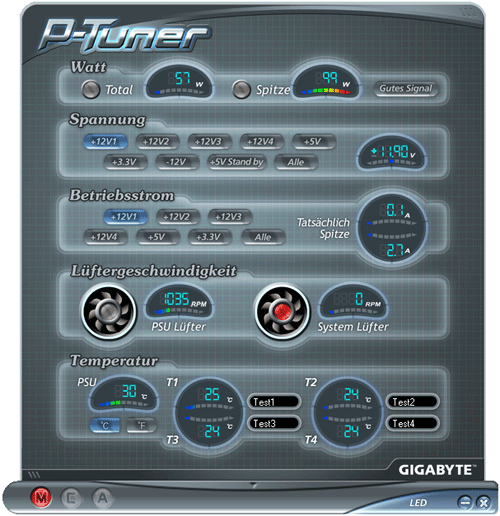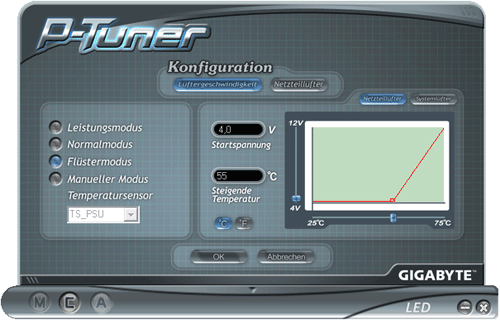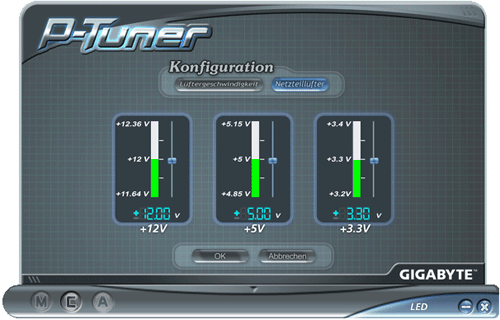Gigabyte's New Odin GT 800W Power Supply
by Christoph Katzer on July 24, 2007 12:01 AM EST- Posted in
- Cases/Cooling/PSUs
The P-Tuner Software, Cont'd

The fourth row with the two rotating fans shows the power supply fan on the left and the connected system fan on the right. We have double-checked the RPM with our equipment and were surprised about the high accuracy of this display.
The last row shows the temperature of the power supply itself and the four connected temperature diodes. To make things easier to remember, the user can name each sensor. Note also that the button to switch off the LEDs is located at the lower right side.

A very interesting area is marked with C on the bottom-left of the control-panel. Here you can actually control the power supply and the attached fans. In the top of the newly opened control are two submenus. The first one shows the control for the fans. You can use this to create your own scheme for how the fan should operate in your system. Caution should be exercised when using this utility, as you can force the fan to run very slowly at high temperatures. This can result in a very hot power supply which is certainly not good for any of the components inside and could easily lead to a PSU failure.

In our opinion, the most useful function of all is hidden under this second submenu. You can actually adjust the voltage supplied by the unit. OCZ was first in the market with this idea about four years ago with their PowerStream line of PSUs, but at that time we only got three potentiometers on the rear of the case, and you weren't given any clear indication of the result of any changes. You simply got a green light if the voltage was within spec or an amber light if it was out of spec. With this software you can regulate the output of the rails, and this should definitely be done since the default settings generate poor results as we saw during our tests. You can see the result of your changes immediately back in the main window so you can get the desired result.
To check how much we could adjust each rail we loaded this unit to its maximum of four times 15A on the 12V rails which is the maximum combined power. The 3.3V and 5V rails were also loaded to max. Running at its limit the rails all dropped below the ideal target values and we tried to use the software to regulate them back to normal. This resulted in the PSU switching off automatically. Remember: you can regulate the rails but there are limits to what you can accomplish.
Unfortunately, this kind of software doesn't come without problems. First of all we need to complain about the high CPU and memory load the software creates. With a typical midrange or better PC it would still be acceptable, but if you're running any demanding applications you might want to shut it off. Also, during the tests on the Chroma we connected the PSU to a second PC (which wasn't being powered by the PSU). While testing and changing to different tests the software always shut down and showed a connection problem with the PSU. This did not happen when the PSU and software were running in a normal PC configuration, but we did find it curious that the software apparently didn't like the results generated by Chroma.

The fourth row with the two rotating fans shows the power supply fan on the left and the connected system fan on the right. We have double-checked the RPM with our equipment and were surprised about the high accuracy of this display.
The last row shows the temperature of the power supply itself and the four connected temperature diodes. To make things easier to remember, the user can name each sensor. Note also that the button to switch off the LEDs is located at the lower right side.

A very interesting area is marked with C on the bottom-left of the control-panel. Here you can actually control the power supply and the attached fans. In the top of the newly opened control are two submenus. The first one shows the control for the fans. You can use this to create your own scheme for how the fan should operate in your system. Caution should be exercised when using this utility, as you can force the fan to run very slowly at high temperatures. This can result in a very hot power supply which is certainly not good for any of the components inside and could easily lead to a PSU failure.

In our opinion, the most useful function of all is hidden under this second submenu. You can actually adjust the voltage supplied by the unit. OCZ was first in the market with this idea about four years ago with their PowerStream line of PSUs, but at that time we only got three potentiometers on the rear of the case, and you weren't given any clear indication of the result of any changes. You simply got a green light if the voltage was within spec or an amber light if it was out of spec. With this software you can regulate the output of the rails, and this should definitely be done since the default settings generate poor results as we saw during our tests. You can see the result of your changes immediately back in the main window so you can get the desired result.
To check how much we could adjust each rail we loaded this unit to its maximum of four times 15A on the 12V rails which is the maximum combined power. The 3.3V and 5V rails were also loaded to max. Running at its limit the rails all dropped below the ideal target values and we tried to use the software to regulate them back to normal. This resulted in the PSU switching off automatically. Remember: you can regulate the rails but there are limits to what you can accomplish.
Unfortunately, this kind of software doesn't come without problems. First of all we need to complain about the high CPU and memory load the software creates. With a typical midrange or better PC it would still be acceptable, but if you're running any demanding applications you might want to shut it off. Also, during the tests on the Chroma we connected the PSU to a second PC (which wasn't being powered by the PSU). While testing and changing to different tests the software always shut down and showed a connection problem with the PSU. This did not happen when the PSU and software were running in a normal PC configuration, but we did find it curious that the software apparently didn't like the results generated by Chroma.










23 Comments
View All Comments
strikeback03 - Tuesday, July 24, 2007 - link
Does the software need to be running for the voltage regulation to work? Or can you make changes then close the software and have the changes still work on the PSU?Also I'd guess if UV lighting is that useful for a case you could swap the blue LEDs for some UV ones - looks like enough wire is exposed to cut the blue ones and solder in UV ones.
Oberst - Tuesday, July 24, 2007 - link
Hello,nice review (i wouldn't expect anything else of you). But I've got a question about the measuring-software: Was it reliable, when measuring voltages? You already mentioned, that the wattage was not reliable. So I'd like to know, if that was because of wrong measured amps or volts.
greets Oberst.
Christoph Katzer - Tuesday, July 24, 2007 - link
Voltages have been quite accurate; amps have been wrong in almost every case.qpwoei - Tuesday, July 24, 2007 - link
Once you've got the ripple measurements sorted out, it'd be nice to get some scope traces as the load changes. Poor transient response of the rails can cause all sorts of hard-to-diagnose problems in the real world.Christoph Katzer - Tuesday, July 24, 2007 - link
We use a scope to follow response on the rails but until now we feel the data is not good enough to present. If there would be something to extraordinary to tell we surely would.bob4432 - Tuesday, July 24, 2007 - link
what about that? a good quality unit, the Corsair 520HX seems to be a lot of people's favorite lately, how does it really stack up? or some of the FSP "Green" units - are they really that efficient? what about seasonic - really as good as everyone says?these reports are all fine and dandy, but you are catering to possibly 5% of your user base, yes even here 800W is extreme overkill.
and it is not a $$$ issue but rather a reality issue. i am surprised you guys testing these are continuing the thought process by only reviewing the upper wattage units and thus making everyone think they need one when they don't - people on review 750W psus, so i must need one...come on guys
Christoph Katzer - Tuesday, July 24, 2007 - link
Will come. No worries about that. At the moment we are just starting as you can see and of course every company wants to have the best PSU tested first. We'll have lower ones very soon but need to work on that mountain of PSUs here first. With 380w you will see a Seasonic pretty soon for example.bob4432 - Tuesday, July 24, 2007 - link
will definitely be looking forward to them :)ATWindsor - Tuesday, July 24, 2007 - link
I disagree that an OCP per rail i s a good thing, it onyl makes using the PSU more of a hassle, since you can draw a lot less from the PSU on 12V than the specs would make possible, if you are unlucky and draw most of it from one rail. Several manufacturers have one big rail without any know safety-problems, having an OCP for the combined drav from the 12V-lines however is a good thing.AtW
dare2savefreedom - Tuesday, July 24, 2007 - link
I would be interested in knowing how a psu runs with dual 8800gtxs in virginia in summertime in an old house with a window air conditioner.Not these theoretical white glove clean room lab environment tests.
triple sli 8800gtx?
come one stop playing with your iphone.